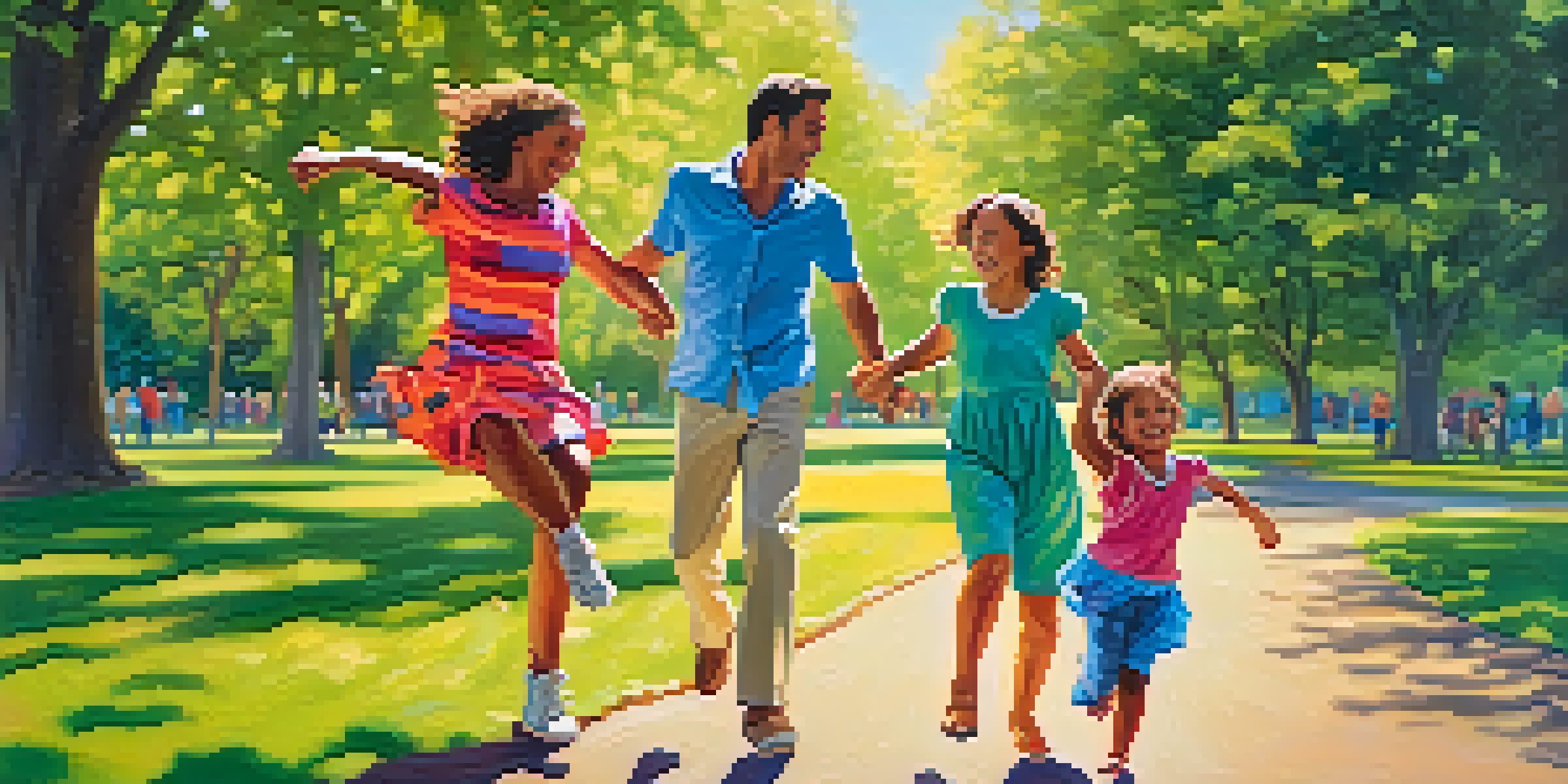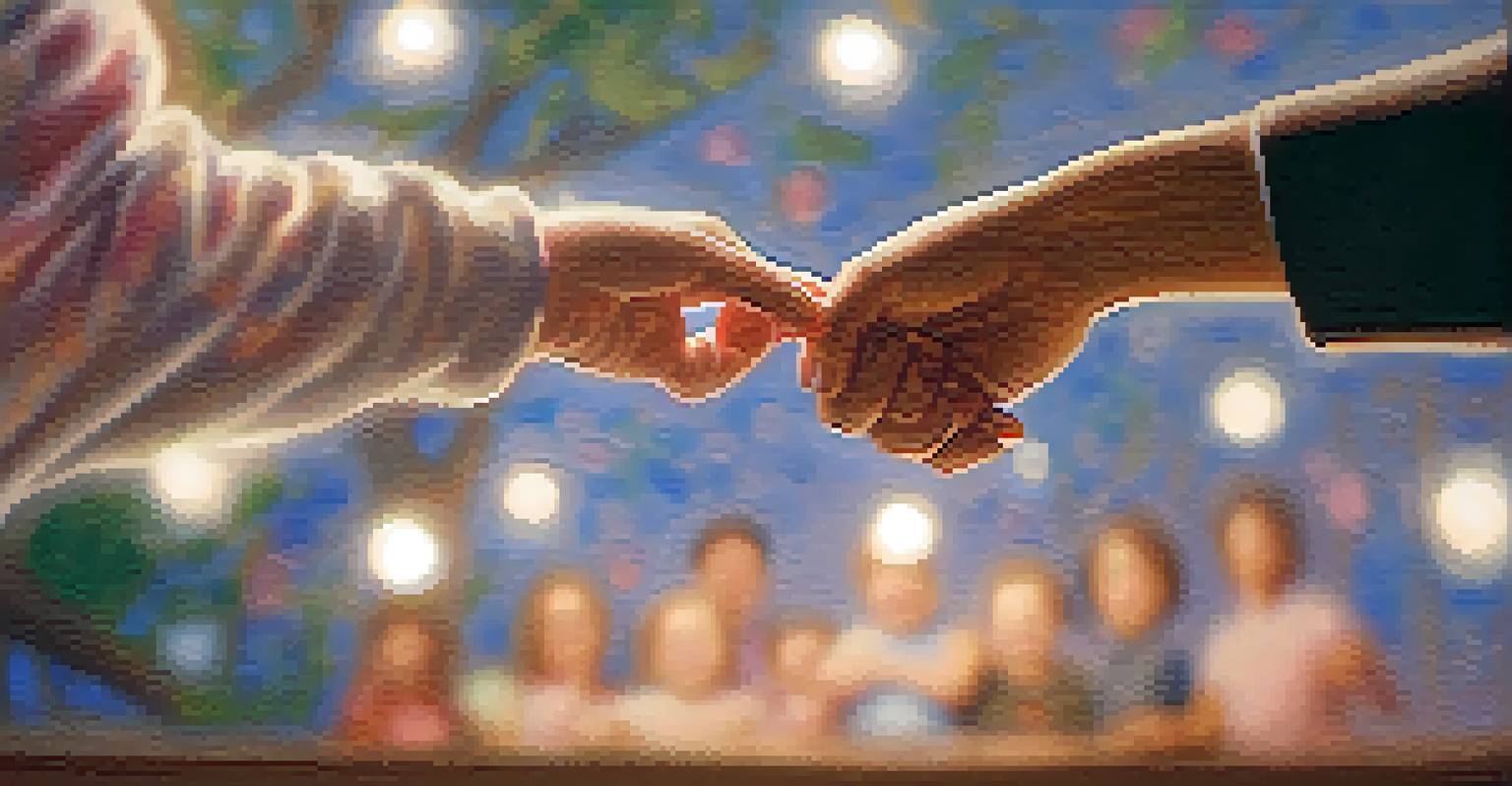Exploring Family Roles through Dance and Performance Art

Understanding Family Roles in Dance and Art
Family roles can be complex and multifaceted, often defined by cultural, social, and personal dynamics. In dance and performance art, these roles can be vividly expressed, allowing participants to explore their identities within the family unit. For example, a family might use a dance piece to depict the roles of caregiver, provider, and nurturer, highlighting how these roles interact and influence each other.
Dance is the hidden language of the soul.
Through movement and expression, dancers can embody the essence of their family roles, making it easier for audiences to connect with these concepts on an emotional level. This exploration can also serve as a therapeutic outlet, helping families communicate feelings that might be difficult to express verbally. By engaging in performance art, families can share their stories and experiences in a powerful and visual way.
Moreover, this artistic exploration can encourage dialogue within the family, prompting discussions about expectations and responsibilities. As family members take on different roles in a dance, they may gain insights into how their actions affect one another. Ultimately, dance and performance art become a means of understanding and redefining family dynamics.
The Power of Nonverbal Communication in Performance
Dance is a unique form of communication that transcends words, allowing individuals to express emotions and relationships through movement. In the context of family roles, this nonverbal language can convey feelings of love, frustration, or support that might otherwise go unspoken. For instance, a child may express their desire for independence through a solo dance, while a parent might respond with a supportive duet, illustrating their bond.

In performance art, the interplay of body language, facial expressions, and spatial relationships can tell a story that is rich in meaning. Audiences can often feel the tension or harmony between family members without needing to understand the specific context. This shared experience of watching can deepen the audience's connection to their own family dynamics, sparking reflection on their relationships.
Dance Reflects Family Dynamics
Through dance and performance art, families can explore and express their roles, enhancing understanding and communication among members.
Additionally, nonverbal communication can foster empathy and understanding among family members. As they witness each other's performances, they may recognize struggles and triumphs that they weren't aware of before. This process of observing and reflecting can strengthen familial bonds and pave the way for more open conversations.
Cultural Influences on Family Roles in Dance
Cultural backgrounds significantly shape family roles, and this influence is beautifully reflected in dance and performance art. Different cultures have unique traditions that highlight specific family dynamics, such as the role of elders or the importance of community. For example, traditional folk dances often celebrate familial ties, showcasing the roles of each member within a communal setting.
Art is the most beautiful of all lies.
When families engage in culturally relevant dances, they can explore their heritage while also reflecting on their own roles. This connection to culture can provide a sense of belonging and identity, reinforcing the values and traditions that shape their family dynamics. Moreover, it allows them to pass these cultural narratives to future generations through performance.
By integrating cultural elements into their performances, families not only honor their roots but also create a space for dialogue about changing roles in modern society. This blending of tradition and contemporary expression can lead to a richer understanding of how culture influences family relationships today.
Creative Collaboration: Family as a Performance Ensemble
Creating a dance or performance piece as a family can foster collaboration and creativity, strengthening bonds among members. This collaborative process encourages everyone to contribute their ideas, skills, and perspectives, leading to a unique expression of their collective identity. For instance, each family member might design their own dance sequence that reflects their role, all coming together to create a cohesive performance.
Through this teamwork, families can learn to appreciate each other's strengths and talents in new ways. This experience not only enhances creativity but also builds trust, as members rely on one another to bring their shared vision to life. It becomes a journey of discovery, where each performance serves as a reflection of their evolving family narrative.
Cultural Roots Shape Family Roles
Cultural influences are evident in dance, allowing families to connect with their heritage while discussing evolving roles in modern society.
Furthermore, performing together can help families navigate conflicts and misunderstandings. As they work through creative differences, they develop problem-solving skills that translate beyond the stage. This collaborative approach reinforces the idea that family is a supportive ensemble, where every role is vital to the overall harmony.
Therapeutic Benefits of Dance for Families
Dance therapy has emerged as a powerful tool for families seeking to enhance their emotional well-being. Engaging in dance can provide an outlet for stress relief, allowing family members to express emotions that may be hard to articulate. For instance, a family dealing with loss may find solace in creating a dance that honors their loved one, fostering healing through movement.
In a therapeutic context, family members can explore their roles and relationships in a safe and supportive environment. This exploration can lead to breakthroughs in understanding and communication, helping families address underlying issues. By participating in dance therapy, families can learn to navigate their dynamics in a constructive manner, ultimately fostering resilience.
Moreover, the act of dancing together can enhance physical health and promote bonding experiences. As families engage in activities that bring them joy, they create positive memories that strengthen their connections. The therapeutic benefits of dance extend beyond emotional healing, contributing to a holistic sense of family well-being.
Creating Rituals: Performance as a Family Tradition
In many cultures, performance art serves as a way to create and maintain family traditions. Whether it's a yearly dance at a family reunion or a special performance during holidays, these rituals can strengthen family ties and provide a sense of continuity. By participating in these events, family members pass down stories and values that shape their identity.
Rituals in performance art can also create a space for reflection and connection. Families can come together to celebrate milestones, such as birthdays or graduations, through dance, making these occasions even more special. These performances become cherished memories that everyone looks forward to, reinforcing the importance of family unity.
Collaboration Strengthens Bonds
Creating dance performances as a family fosters collaboration and creativity, helping to build trust and resolve conflicts.
Over time, these rituals can evolve, allowing families to incorporate new elements or themes that resonate with their current dynamics. As they adapt their performances, they reflect their growth and changes as a family unit. This ongoing tradition of performance not only preserves their heritage but also encourages innovation and creativity.
The Future of Family Roles in Dance and Performance
As society continues to evolve, so too do the roles within families. Dance and performance art are reflective of these changes, providing a platform for families to explore contemporary issues such as gender roles, parenting styles, and societal expectations. For instance, families may engage in performances that challenge traditional norms, showcasing a more diverse and inclusive representation of family dynamics.
The future of family roles in dance also involves embracing technology and new forms of expression. Virtual performances and digital choreography allow families to connect in innovative ways, expanding their reach and impact. This adaptability highlights the resilience of families as they navigate new challenges and opportunities in a rapidly changing world.

Ultimately, the exploration of family roles through dance and performance art will continue to be a vital part of our cultural narrative. By engaging in these artistic expressions, families not only celebrate their unique stories but also contribute to a broader dialogue about the evolution of family in society. This ongoing journey ensures that the art of performance remains a valuable medium for understanding and honoring family dynamics.